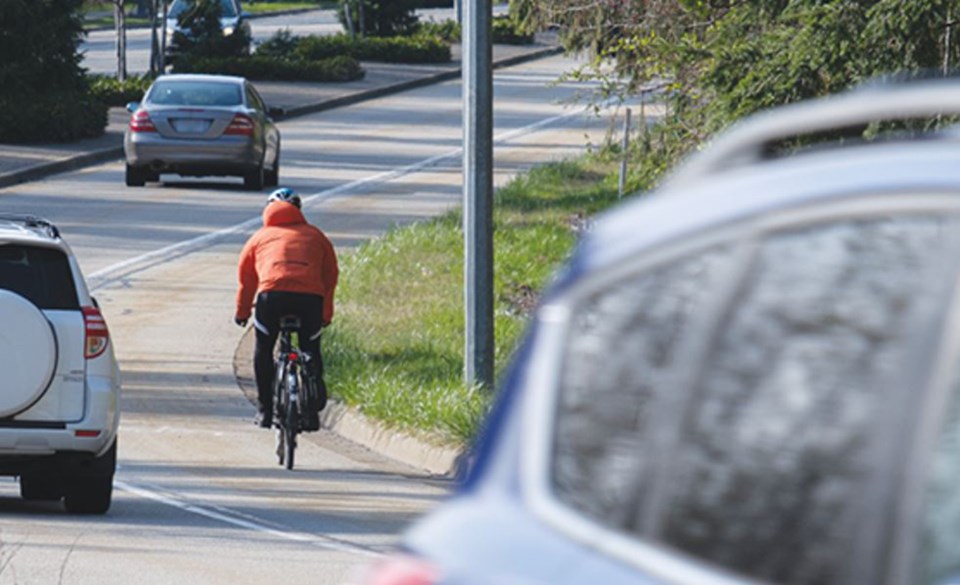The Editor:
As an avid transportation and recreational cyclist, I am wondering what is going on with the development of a cycle network in Burnaby as it relates to the city's first Official Community Plan (OCP) in 1998 and then revised again in September 2023.
In my opinion, Burnaby has failed spectacularly in their transportation goals of Section 8.5 of the 1998 and 2023 revised OCP, The Future , “These measures are intended to reduce the role of the single occupant vehicle in the day to day transportation needs of the Region and provide a better means to integrate the land uses in the region…”
I ask, what has Burnaby done to make meaningful inroads to bring cycling to the forefront and reduce the single occupant vehicle in the last 30 years?
In my opinion, little to nothing.
According to the city’s website, Burnaby’s Cycle Network has 70 km of a cycle network. Seventy kilometres includes semi-slow "side" roads like the much used Frances/Union, steep pathways like Royal Oak, Buckingham Heights, Caribou Road, or Weyburne near BCIT and Lougheed and Barnet Highways, as well as the Central Valley Greenway in north Burnaby and the BC Parkway in the south.
Nothing new, literally, for years.
Some new cycling infrastructure has been built in the last 10 years but it would not account for much more than 5 per cent or 3.5 km. After 30 years! There is one new bi-directional track on Still Creek; a bit of "town centre" cycling design between Gaglardi/Lougheed Highway to Lougheed Mall, some terribly steeply and mostly unused multi-use path near Byrne Creek in South Burnaby, and a little bit of a multi-use path on Deer Lake Parkway near City Hall. I think we are also waiting for some additional unwanted multi-use paths on Marine Way. With the exception of Still Creek I would consider all these additions as examples that represent unsafe, indirect, uncohesive, and uncomfortable infrastructure foisted upon cyclists. But they do add up to the seventy kilometres the City touts as their "cycle network."
Looking at the 1998 Cycle Roads Network in the Official Community Plan (OCP) 8.4.3.1., the map itself offers large dark lines snaking through Burnaby. So it would appear to the unpractised eye an impressive grid of cycling roads and alternate cycle roads going east to west, north to south. Excellent you would think, everyone from all over Burnaby should be able to travel safely and easily throughout our community, job done!
But those dark lines are not nearly as impressive as they seem because they fail the actual test of getting more people riding and more people riding safely between two points because of course between the two points is the Cycle Road that needs to be ridden.
One example: Gilmore Avenue was once highly used as a good north/south cycle road that took cyclists from North Burnaby up to BCIT, Electronic Arts, and south to Central Park. This route has been obliterated by high car usage on a narrow road along with the development of towers at Gilmore/Lougheed and Gilmore/Douglas Road. The result has left cyclists to their own devices by allowing a hodge podge of sidewalk, roadway, multi-use paths and town center design pathway. This route forces cyclists to cross back and forth from east to west to ride south or north and mix with pedestrians and cars to move north or south.
Or Willingdon Avenue. Willingdon was once touted as a Cycle Road. You might think the almost $11 million invested in this "linear parkway" on the east side of Willingdon Avenue created by former Mayor Derek Corrigan is helpful. It is not. This is really a multi use path (MUP) open to dog walkers, children and everyone else as well cyclists. It is too narrow, connects to nothing and really ends up nowhere. Pedestrians and cyclists should not share space any more than cars and cyclists should share road space.
So, 30 years on, and about six city councils later, the city is still pumping out its myth of Cycle Roads in the OCP. I say the city has not even tried to build a safe, direct, cohesive, comfortable and fun (yes, fun) cycle network in and around Burnaby.
A climate crisis is upon us; the city has the means to make our city a great space for everyone of all ages and abilities, but the question is, “Will they and what will it take?”
- Cathy Griffin, Burnaby



